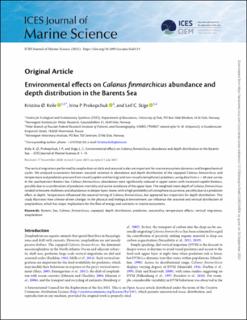Environmental effects on Calanus finmarchicus abundance and depth distribution in the Barents Sea
Peer reviewed, Journal article
Published version
Permanent lenke
https://hdl.handle.net/11250/2786440Utgivelsesdato
2021Metadata
Vis full innførselSamlinger
- Publikasjoner fra Cristin - NIVA [2160]
- Scientific publications [1172]
Sammendrag
The vertical migrations performed by zooplankton at daily and seasonal scales are important for marine ecosystem dynamics and biogeochemical cycles. We analysed associations between seasonal variation in abundance and depth distribution of the copepod Calanus finmarchicus and temperature and predation pressure from visual (capelin and herring) and non-visual (ctenophores) predators, using data from a > 30-year survey in the southwestern Barents Sea. Calanus finmarchicus abundances were significantly reduced in upper waters with increased capelin biomass, possibly due to a combination of predation mortality and active avoidance of the upper layer. The weighted mean depth of Calanus finmarchicus tended to become shallower, and abundances in deeper layers lower, with a high probability of ctenophore occurrence, possibly due to a predation effect at depth. Temperature influenced the seasonal timing of Calanus finmarchicus, but appeared less important for depth distribution. This study illustrates how climate-driven changes in the physical and biological environment can influence the seasonal and vertical distribution of zooplankton, which has major implications for the flow of energy and nutrients in marine ecosystems.

